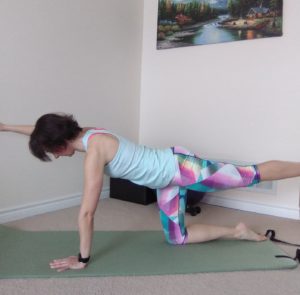The pelvic floor is essentially a web of muscles that acts like a basket holding up your internal organs such as bladder, bowel and uterus. When these muscles become weakened – from things like childbirth, heavy lifting, chronic coughing (basically anything that puts a lot of pressure on it) it can cause a loss of bladder or bowel control and can increase the risk of prolapse. Weak pelvic floor muscles can also put strain on other muscles as it is connected to many other muscles in the body, causing them to work overtime to make up for the lack of support in the pelvic floor. This imbalance can cause pain in other areas of the body too, for example lower back pain or hip pain, also can cause incontinence and weaken support and stabilization of the spine.
For these reasons, it’s important to make sure you’re incorporating pelvic floor and core exercises into your workouts regularly to strengthen pelvic floor. And don’t worry – the workouts don’t have to be long or strenuous. But just like every other muscle in the body, they need attention in order to maintain the strength needed to function properly.
 In Pilates pelvic floor muscles are considered as core muscles, because they help to support and stabilize the spine. It is important to know how to activate those muscles during weight training, heavy lifting or running to support the stability of your body and to prevent injuries.
In Pilates pelvic floor muscles are considered as core muscles, because they help to support and stabilize the spine. It is important to know how to activate those muscles during weight training, heavy lifting or running to support the stability of your body and to prevent injuries.
Some of the most common pelvic floor strengthening exercises are Kegel. Kegel exercises are named after Dr. Arnold Kegel, the obstetrician who first developed them. They are also called Pelvic Floor Muscle Training (PFMT). There are two types of Kegel exercises: ordinary or fast Kegels, and elevator or slow Kegels.
Before doing either type of PFMT, locate the pelvic floor muscles that need strengthening. They are the muscles used to stop a stream of urine mid-flow. You can practice locating these muscles by trying to stop in the middle of urinating.
When engaging pelvic floor muscles, you should be feeling a slight compression around your waistline. Make sure your glutes (bum muscles) stay relaxed and your spine doesn’t change its curve.
Fast Kegels
Fast, or ordinary Kegel exercises, involve contracting the pelvic muscles tightly for increasing lengths of time. Squeeze your pelvic floor muscles, hold for five seconds, then relax for five seconds. Beginners should repeat four or five times in a row.
When that becomes easy, work up to holding the muscles tight for 10 seconds at a time, with a 10 second rest between each contraction. For best results, Kegel exercisers should aim for three sets of 10 repetitions daily. Fast Kegel exercises may be done while sitting, standing or lying down.
Slow Kegels
Slow Kegels increase muscle endurance. They are also called Elevator Kegels because visualizing the rising and descending motions of an elevator helps you perform them correctly.
Slowly contract your pelvic floor muscles while envisioning an elevator going from the first to the tenth floor, the strength of your muscle contraction growing with each count. Hold for a count of five seconds, then slowly release the muscles while counting back down to one. It’s equally important to learn how to relax or release pelvic floor muscles as tighten or contract them.
As your endurance increases, you should increase your strongest holding count to 10 seconds. Elevator Kegels require a bit more concentration, but may also be performed discreetly while sitting, standing or lying down.
If you want to go even further and strengthen other muscles that are part of your core, Pilates exercises are the best way to go. They are mostly performed on a mat in a sitting position, on your back or on the stomach. They are low impact and perfect fit for people who want non weight bearing workout, such as runners on their active recovery day or people with joint issues. Whether you are a new mom, recovering after child birth or an avid athlete looking for more stability and endurance, strengthening your core and pelvic floor muscles will give you a sense of strength and control from within, improve your well being and help you to minimize injuries down the road.
